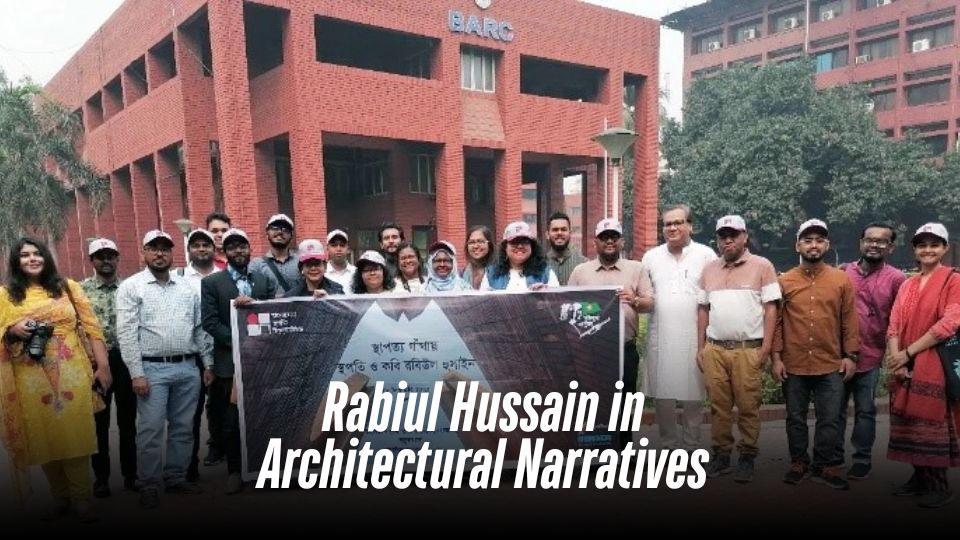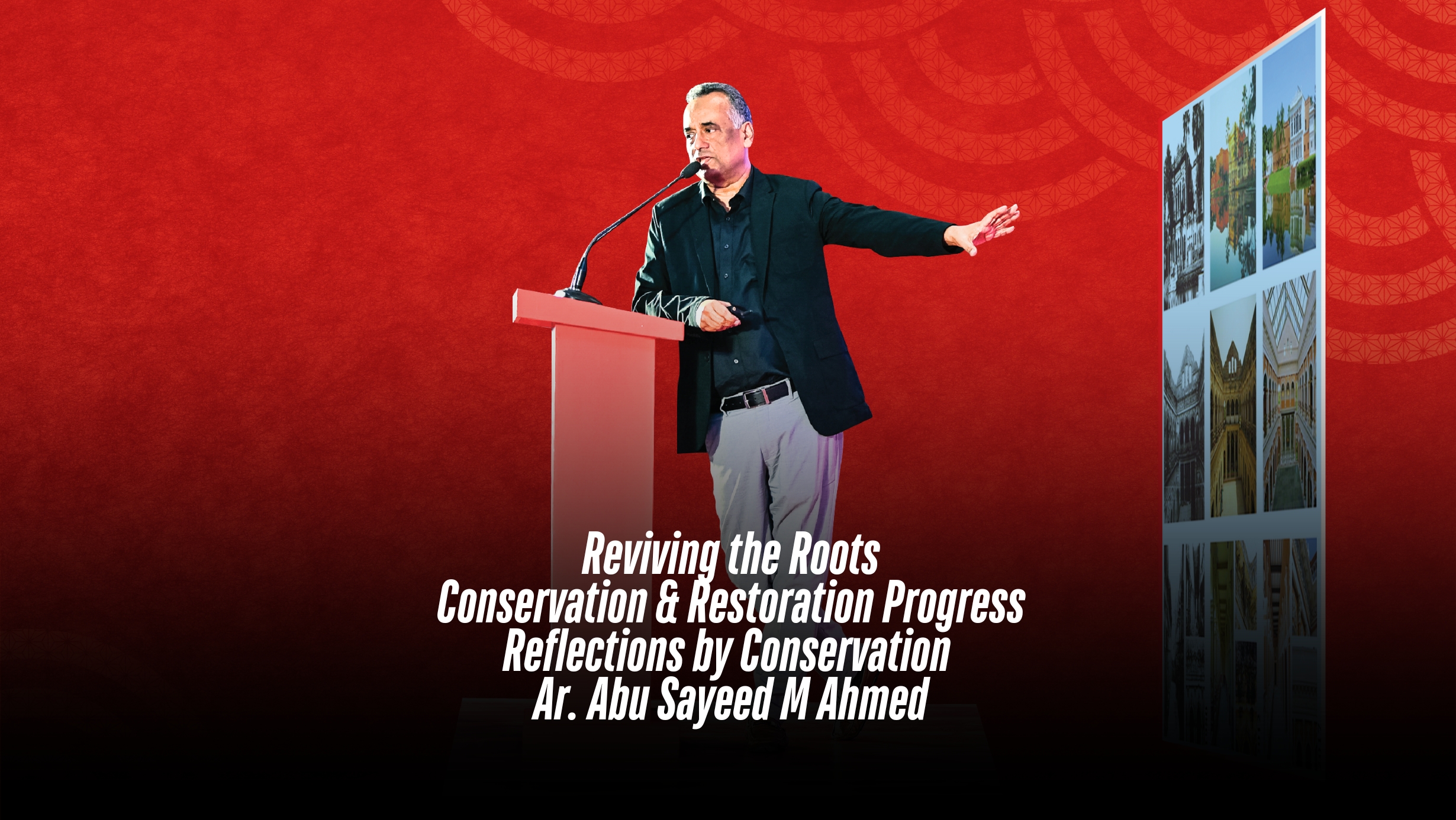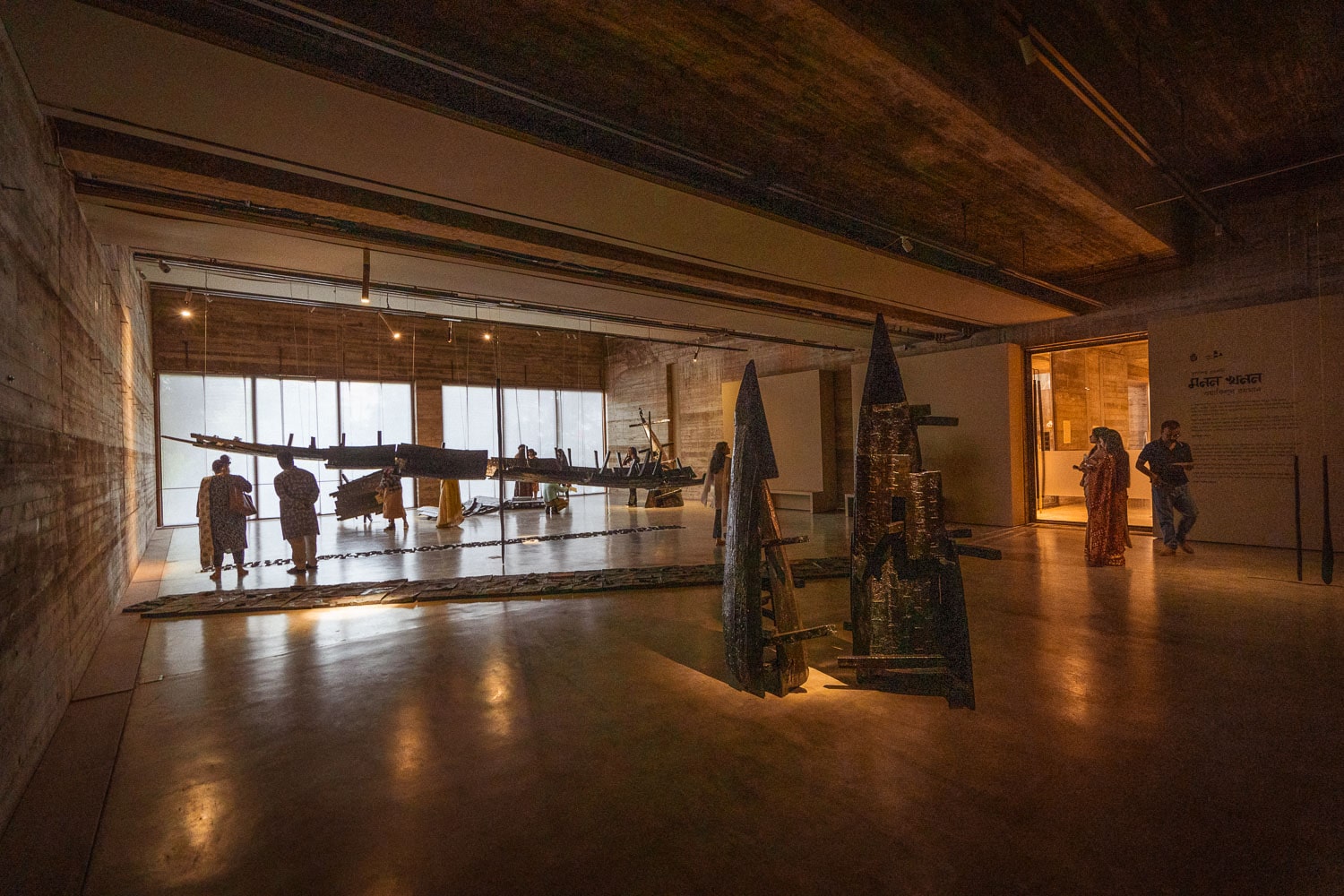
Rabiul Hussain in Architectural Narratives
On February 28, 2025 Bangladesh Institute of Architects (IAB) and the Bangladesh Liberation War Museum organized a day-long program to tribute architect Rabiul Hussain through visiting 3 of his projects- Bangladesh Agricultural Research Council (BARC), Jalladkhana Killing Ground and Jahangirnagar University. and taking a vow to protect the diversified works of the architect. Architect Rabiul Hussain (January 31, 1943 – November 26, 2019) was a prominent Bangladeshi architect, poet, art critic, short story writer, essayist, and cultural activist. A person of multifaceted talent, honored by the Government of Bangladesh with the Ekushey Padak for his contributions to language and literature in 2018, received the Bangla Academy Literary Award for his contributions to poetry in 2009, and the Bangladesh Institute of Architects (IAB) awarded him the Gold Medal for his outstanding contribution to architecture in 2016. He served four times as the President of the Bangladesh Institute of Architects, Vice-Chairman of the Architects Regional Council of Asia (ARCASIA), Vice-President of the Commonwealth Association of Architects, and President of the South Asian Association for Regional Cooperation of Architects. In addition, he was a trustee of the Liberation War Museum, an executive member of the 1971 Ghatok Dalal Nirmul Committee (Committee for Elimination of Martyrs’ Assassination), and made significant contributions to the preservation of the memories of the Independent War of Bangladesh. Although he was born in the village of Ratidanga in Shailkupa Upazila, Jhenaidah District, he completed his secondary and higher secondary education in Kushtia District. Later, in 1968, he earned his Bachelor degree in architecture from the then East Pakistan University of Engineering (now Bangladesh University of Engineering and Technology). After obtaining the graduation, he began his professional career as an architect working with architect Mazharul Islam and later joined Shahidullah Associates. Alongside his architectural practice, he also maintained a strong passion for writing. Throughout his career, he served as a life member of the Bangla Academy, and was involved in various organizations, including the Central Kachi-Kachhar Mela (a children’s and youth organization), the National Poetry Council, the Bangabandhu Sheikh Mujibur Rahman Memorial Museum, the International Film Critic Association of Bangladesh, and the Bangladesh Institute of Architects. Notable buildings designed by him include the Jalladkhana(Execution House), the Bangladesh Agricultural Research Council building, the entrance gate of Dhaka University, the Liberation and Independence Arch, the Jahangirnagar University gate, the Bhashani Hall, the Bangabandhu Hall, the Sheikh Hasina Hall, the Khaleda Zia Hall, the Wazed Mia Science Complex, the auditorium and academic building complex of Chittagong University, and alongside architect Mazharul Islam, the Bangladesh Agricultural Research Institute in Gazipur, Haji Mohammad Danesh Science and Technology University in Dinajpur, and polytechnic institutes in Chittagong and Khulna, among others. Bangladesh Agricultural Research Council (BARC) The Bangladesh Agricultural Research Council (BARC) was established in 1973 with the aim of conducting agricultural research and coordinating various related institutions in Bangladesh. Almost a decade after its founding, in 1982, architect Rabiul Hussain designed its current building. The design process, which began in 1978, spanned nearly four years. In a remarkable way, he crafted a unique architectural design using red brick masonry that harmonized with Bangladesh’s climate, nature, and way of life. This building is a symbol of post-independence architecture, reflecting a search for an architectural style; that is free from the burden of colonization in a newly liberated land. Each detail of the building echoes the same vision. The regional architectural influence of Maestro Mazharul Islam, the pioneer of Bangladesh’s regional architecture, is evident in the design, which he was fortunate to experience starting from his third year of architectural education. The building, located on a site shaped like the letter ‘L’ in the English alphabet, is easily noticeable among surrounding roads and structures. It stands at the junction of Airport Road and Khamar Bari Road, near Farmgate and Bijoy Sarani. The design symbolizes various aspects of aesthetic gravity, marking an early effort in the evolution of post-independence Bangladeshi architecture and the search for a Bengali “identity” in the country’s-built environment. The location of the building, near the capital’s main international airport at Tejgaon, limited the building’s height to four floors. The rectangular building, measuring 223 feet in length and 63 feet in width, has a total built-up area of 32,700 square feet. It is aligned along the east-west axis and is equipped with optimal provisions for cross-ventilation and prevailing south winds. The three-story building is vertically divided into three functional zones. The first floor is allocated for administrative offices; the second floor houses the executive branch. The third floor features a 7,500-square-foot conference room with seating for 280 people at its center, along with a 1,350-square-foot library and a meeting room. The first and second floors are organized along a double-loaded corridor, with two staircases at the eastern and western ends of the building. In harmony with local traditions, the roof was projected to protect the building from torrential rain and scorching sun. The BARC building essentially consists of two parts: one is the brick-clad inner shell that spans the main area, while the additional levels moderate the harsh tropical sun and protect the building during the monsoon season. Architect Mazharul Islam’s office- Vastukalabid was a key influence in experimenting with such a critical combination of climate consideration and modernist aesthetics along with that of brick mason for architect Rabiul Hussain and many young architects in the early 1970s. To give an example, his designs, including the National Institute of Public Administration (1964), encouraged a generation of architects to explore “critical regionalism” through a lens that considered climatic aspects in the visual language of architecture. Since stone is rare and fired bricks can be produced in abundance from local clay, architects saw bricks as an unprecedented symbolic representation of the delta and its culture. Representing the soil of the riverine country, bricks were the purest or most organic building material believed by the Bangladeshi architects. The “poetry” of bricks is hard to miss in the concept and construction of the BARC headquarters building. Also, the influence of

Reviving the Roots: Conservation & Restoration Progress Reflections by Conservation Architect Abu Sayeed M Ahmed
At the anniversary celebration of Ceramic Bangladesh Magazine, esteemed conservation architect and heritage specialist Abu Sayeed M Ahmed presented “Reviving the Roots: Conservation and Restoration Progress”—a heartfelt journey through two decades of architectural conservation across Bangladesh. With vivid images and powerful anecdotes, he reminded the audience that conservation is not about romanticising ruins—it is about safeguarding identity, craftsmanship, and cultural continuity in a nation at risk of forgetting itself. “Every day in Dhaka, a piece of our heritage vanishes. Buildings are bulldozed in the name of development. But without roots, how can we grow a future that is truly ours?” Bringing History Back to Life Nimtali Deuri & Naib-Nazim Museum, Dhaka Abu Sayeed M Ahmed’s first major restoration was the late Mughal-era Nimtali Deuri in Old Dhaka. Hidden under layers of plaster. The restored gateway now houses the Naib-Nazim Museum, commemorating the deputy governors of Dhaka and reflecting a revived connection between the city and its Mughal past. Uttar Halishahar Mosque, Chattogram This 200-year-old mosque was facing demolition for modern expansion. Upon assessment, its authentic Mughal character became evident. Abu Sayeed’s team removed inappropriate cement layers, dismantled an added veranda, and re-clad it in traditional lime and surki. Locals now call it a “Gayebi Mosque”—as if it reappeared by miracle. Nearby, a new mosque by Architect Kashef Mahboob Chowdhury respectfully contrasts the old, echoing its jali motifs in modern concrete. Hanafi Jame Mosque, Keraniganj Once a modest family-owned mosque, it gained global recognition after restoration—winning a UNESCO Award. A new mosque built adjacent to it by Architect Kashef Mahboob Chowdhury, with full visibility of the old structure—offers a striking example of architectural dialogue between past and present, tradition and transparency. Rediscovering Rural Heritage Buraiich Maulvi Bari, Faridpur Neglected and engulfed by vines, this ancestral home seemed destined for ruin. Through sensitive restoration, it has been transformed into a heritage Airbnb, preserving its traditional character while offering economic sustainability. Period furniture, handpicked materials, and contextual storytelling give visitors a window into Bengal’s rural past. Mithamoin Kachari Bari, Kishoreganj This decaying administrative house—once thought beyond repair—was restored to reflect its original civic purpose. From a wild, overgrown ruin, it emerged as a dignified reminder of regional governance and colonial-era architecture, now serving as an active public building. Urban Civic Revival Narayanganj Municipal Building Among Bangladesh’s earliest municipal structures, it was at risk of being replaced. A dual solution—preserve the old and integrate it into the new. Today, it functions as the entrance to the new Nagar Bhaban (City Hall), and plans are underway to convert its upper level into a civic museum. Baro Sardar Bari, Sonargaon A Mughal-Colonial mansion from the Baro-Bhuiyan era, this structure was revived through corporate social responsibility. South Korea-based Youngone Corporation led the project under the leadership of CEO Kihak Sung, who has familial roots in the region. This model highlights how private sector investment can play a crucial role in cultural restoration. Reviving Lost Icons Dhaka Gate (Mir Jumla Gate) Once a neglected and overgrown monument, the historic city gate has been revitalised with its original grandeur—complete with a replicated fire cannon that signals its defensive legacy. Rose Garden Palace, Tikatuli, Dhaka A jewel of Dhaka’s architectural heritage, the Rose Garden was meticulously restored—from stained-glass panels to ornamental plasterwork. Where pieces were missing, they were reconstructed based on archival records, ensuring authenticity over imitation. Hammam Khana, Lalbagh Fort Perhaps the most complex restoration, the Mughal-era bathhouse had suffered colonial and post-colonial misuse. Funded by the U.S. Ambassador’s Fund, the project uncovered a breathtaking pavilion structure, restored lighting from above (true to hammam tradition), and reestablished the original spatial and sensory quality of the Mughal bathhouse. Crafting the Future with the Past Reviving Chini Tikri Ornamentation A rare local tradition, Chini Tikri—the use of broken ceramic dinnerware to form decorative motifs—was resurrected. The team digitally reconstructed patterns, reproduced the plates, broke them and reapplied them by hand. This craft was even adapted into a contemporary mosque in Noakhali, designed by Architect Mamnoon Murshed Chowdhury and Architect Mahmudul Anwar Riyaad, using waste ceramic products donated by Monno Ceramics. These projects demonstrate what is possible when craftsmanship, community, and conservation come together. They are not just restorations—they are cultural revivals, offering spaces where memory, faith, and identity continue to live. Written by Samia Sharmin Biva

Bangladeshi Hotels, Resorts Win Big at South Asian Travel Awards 2025
Bangladesh’s hospitality sector received a resounding endorsement on the international stage as several leading local hotels, resorts, and tour operators were honoured at the South Asian Travel Awards (SATA) 2025, held at the Cinnamon Grand in Colombo. The glittering ceremony, widely regarded as one of the region’s most prestigious events in the travel and tourism calendar, brought together top-tier organisations from Sri Lanka, India, the Maldives, Nepal, Bhutan, and Bangladesh. A total of 53 Gold Awards and 113 Silver Awards were presented across a range of categories, recognising excellence in service, innovation, and guest experience. Bangladeshi winners spanned multiple categories, reflecting the country’s growing reputation as a destination of choice for regional and international travellers. Award Winners from Bangladesh Baywatch: South Asia’s Best New Hotel and South Asia’s Leading Beach Resort HANSA – A Premium Residence: Leading Designer Hotel/Resort Holiday Inn Dhaka City Centre: Leading City Hotel Intercontinental Dhaka: Leading Luxury Hotel Momo Inn: Leading Family Hotel & Resort and Leading Convention Center Award Platinum Grand: Leading Boutique Hotel Platinum Residence: Leading City Hotel and Leading Budget Hotel Radisson Blu Chattogram Bay View: Best Eco-Friendly Hotel Radisson Blu Dhaka: Leading Airport Hotel and Leading Meeting & Events Sayeman Beach Resort: Leading Wedding Hotel/Resort Sayeman Heritage: Leading Heritage Hotel/Resort The Palace Luxury Resort: Leading Palace Hotel The Peninsula Chittagong: Best CSR Program, Leading F&B Hotel, and Leading Business Hotel The Westin Dhaka: Leading Wellness and Spa Hotel/Resort Bangladesh Tour Group (BTG): South Asia’s Leading Inbound Travel Agent and Best Promotion Campaign in South Asia Travel Classic (Pvt.) Limited: Leading Travel Agent – Outbound Winning awards in different categories was no easy feat. Each submission underwent a rigorous selection and evaluation process. The SATA 2025 Awards were presented to organisations that embody excellence in service delivery, innovation, sustainability, leadership, and overall industry impact. During the evaluation stage, 60 percent of the marks came from the professional judges’ report cards, with the remaining 40 percent from online public voting. Judges scored submissions based on multiple criteria: service excellence, innovation and improvement, customer satisfaction, sustainability and responsibility, operational excellence and safety, sales and revenue performance, leadership and team development, and industry contribution. This year, SATA placed particular emphasis on sustainability, cultural authenticity, and digital innovation. “SATA brings together over 300 delegates from across the South Asian region to celebrate the best of South Asian hospitality brands,” said SATA President Ismail Hameed at a press conference held during the event. He added that international establishments such as the Taj Mahal Palace, as well as brands from Nepal and Bhutan, which are unique in their own right, took part in this year’s show. “From travel agents’ associations to hotel associations to tourism boards — all are part of SATA,” Hameed said. He noted that South Asian destinations hold great tourism potential, offering everything from cool weather and beaches to mountains, heritage, history, culture, food, and delicacies. Md Mohsin Hoq Himel, Secretary of the Bangladesh International Hotel Association (BIHA), who attended the event, said: “BIHA has been working with the South Asian Travel Awards in Bangladesh.” Under the overall guidance of Hakim Ali, founder of BIHA, the association has participated in the prestigious event every year, he said. Through this platform, BIHA aims to highlight the service standards of Bangladesh’s local hotels and resorts, showcasing their uniqueness and distinctiveness alongside other regional hotels, Himel added. “This year, every Bangladeshi hotel and resort has achieved remarkable positions. We extend our heartfelt congratulations to all the award winners.” According to representatives of Bangladesh’s hospitality sector, this international recognition will further advance the country’s tourism and hotel industry in the global market and strengthen Bangladesh’s brand image worldwide, he said. The first edition of the South Asian Travel Awards began in 2016 and has been organised by Highrise every year since, with the support of multiple associations and tourism bodies from across the South Asian region, according to the SATA website. The annual search for South Asia’s most outstanding travel organisations spans a month each year from March to April, calling upon industry professionals to name their preferred travel suppliers in the region who have risen above the competition and surpassed expectations, it read. “The awards programme continues to serve as a platform for nations to come together, not in competition, but in celebration of shared triumphs and brilliance.” Written by Nibir Ayaan














